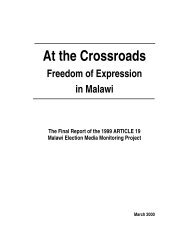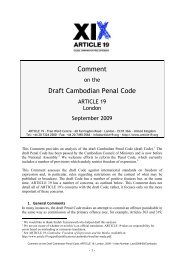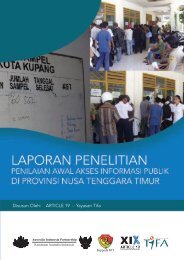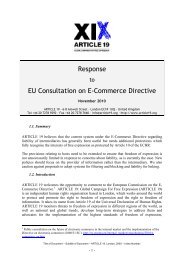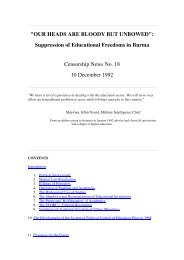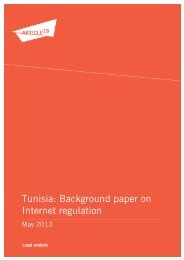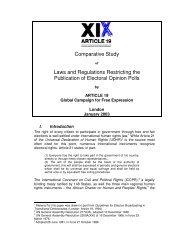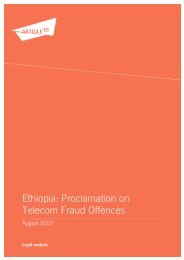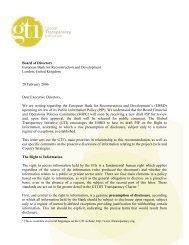FOR INTERNAL USE ONLY - Article 19
FOR INTERNAL USE ONLY - Article 19
FOR INTERNAL USE ONLY - Article 19
- No tags were found...
Create successful ePaper yourself
Turn your PDF publications into a flip-book with our unique Google optimized e-Paper software.
ARTICLE <strong>19</strong>GLOBAL CAMPAIGN <strong>FOR</strong> FREE EXPRESSIONorder to hold accountable those responsible. Conclusive information about the accident could assistthem in overcoming its consequences, both psychologically and logistically. Only full transparencyand analysis of what happened will enable the State and society to learn from these events.While it is no surprise that information was suppressed during the Soviet period, it is worryingthat the lack of comprehensive information on the Chornobyl accident and its consequences persistseven today. This is in part due to logistic reasons, such as the fact that no comprehensive records werekept at the time about the affected population or the measures taken (for example, how many peoplewere relocated and to where). However, a more comprehensive information policy would have beenbeneficial, as the severe mental health problems created by Chornobyl are exacerbated by the lack ofinformation. A spokesperson from the UN Development Programme (UNDP) stated that ‘two decadesafter the Chornobyl accident people still lack the information they need to lead the healthy andproductive lives that are possible’. 342 As a result, the UNDP has advised the Ukrainian government totake the necessary measures to inform people about living safely in inhabited areas of lowcontamination.;,4 !%>6 The people interviewed (see Chapter 6) referred to several other instances in which lack ofenvironmental information negatively affected their health and quality of life.In Sloviansk, people living near an old sodium factory complained that, despite its closure, asubstantial amount of phosphorus remained on the site. The waste is highly inflammable and fireshave occurred. 343 Although the authorities often conceal information ostensibly in order to avoid panic,in reality the lack of information often leads to public consternation when accidents occur. Slovianskis an example of this: in early 2000, a serious accident in the factory led to leaks of phosphorus gases;in 2004, when a second minor accident took place, the authorities did not issue an official statement,causing a period of uncertainty and fear, as well as confusion as to what body to address forinformation. Moreover, the continued presence of the phosphorus raises great concern, exacerbated byuncertainty and frustration caused by the absence of any known official plan to dispose of thehazardous substances. Interviewees said that they had not received information on safety measures in342 Chernobyl: the True Scale of the Accident. 20 Years Later a UN Report Provides Definitive Answers andWays to Repair Lives, World Health Organisation News Release, 5 September 2005http://www.who.int/mediacentre/news/releases/2005/pr38/en/print.html343 Fortunately the fires were contained.For Internal Use Only. Is Post-Chornobyl Ukraine Ready for Access to Environmental Information?ARTICLE <strong>19</strong>, London, 2007*+



